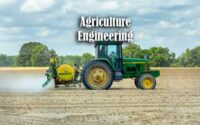Soil Science GK
1. The best soil structure for favourable physical properties is :
(1) Crumby and gramular
(2) Platy and laminar
(3) Columnar and prismatic
(4) Blocky
2. The natural aggregates of soil are known as :
(1) Peds
(2) Clods
(3) fragments
(4) gravels
3. The degree to which a soil resists deformation when a force applied is termed as :
(1) Field capacity
(2) Capillary capacity
(3) Consistency
(4) Friability
4. The soil has porosity of 40%, its void ratio is –
(1) 0.60
(2) 1.50
(3) 0.40
(4) 0.67
5. The following soil water is held due to adsorption forces –
(1) Gravitation water
(2) Capillary water
(3) Hygroscopic water
(4) Hygroscopic and capillary water
6. The rate of decomposition of lignins and phenolic compounds is –
(1) Rapid
(2) Very slow
(3) Slow
(4) Medium
7. The decomposition of organic matter in soil reduces :
(1) Acidity
(2) Alkaltnity
(3) Fertility
(4) Salinity
8. The suitable nitrogen fertilizer for sodic (Alkali) soils is ;
(1) Sodium nitrate
(2) Ammonium sulphate
(3) Urea
(4) Ammonium chloride
9. Which of the following is a safe limit of RSC (Residual Sodium Carbonate) of irrigation water proposed by Eaton (1950) ?
(1) <1.25me/l
(2) >25me/l
(3) <5me/l
(4) >75mell
10. The disease resistance in plants is imparted by –
(1) Potassium
(2) Molybdenum
(3) Nitrogen
(4) Manganese
11. The deficiency symptoms of Calcium and Boron are generally observed on:
(1) Young leaves in terminal bud
(2) Older leaves
(3) Lower leaves
(4) Older and New leaves
12. Application of muriate of potash is generally not recommended for –
(1) Wheat, Barley, Mustard
(2) Bajra, Sorghum, Maize
(3) Sugarcane, Sugarbeet, Tobacco
(4) Groundnut, Sesamum
13. Diammonium phosphate contains –
(1) 46% N and 18% P2O5
(2) 18% N and 46% P2O5
(3) 20% N and 20% P2O5
(4) 18% N and 20% P2O5
14. The essential constituent of Chlorophyll is –
(1) Calcium
(2) Sulphur
(3) Nitrogen
(4) Iron
15. The “Khaira disease” of paddy is mainly due to the deficiency of :
(1) Iron
(2) Manganese
(3) Zinc
(4) Copper
16. Which of the fertilizer contains citric acid soluble phosphoric acid ?
(1) Basic slag
(2) Rock phosphate
(3) Single super phosphate
(4) Triple super phosphate
17. Odd out from the following which does not relate to chain survey.
(1) Metric chain
(2) Jacob’s chain
(3) Gunter’s chain
(4) Engineer’s chain
18. Which of the following field is largest ?
(1) Field-A : 10 square kilometer
(2) Field-B : 100 hectare
(3) Field-C : 625 acre
(4) Field-D : 2500 vigha
19. Which one of the following is the latest survey equipment ?
(1) DGPS
(2) Theodolite
(3) Total survey station
(4) Dumpy level
20. The line joining the places having equal rainfall is called –
(1) Isobaths
(2) Isohyets
(3) Isotherms
(4) Contours
| MCQs | Quiz |
| GK | Questions and Answers |
21. A convenient starting point to describe the hydrologic cycle is in the –
(1) Ocean
(2) Lake
(3) Earth
(4) atmosphere
22. In hydrologic analysis the volume of water is often expressed as –
(1) Average depth over the catchment
(2) m3
(3) m3/unit area of the watershed
(4) m3/s
23. Recurrence interval or return period of a rainfall event is expressed as –
(1) T=1/P
(2) T=K.p
(3) T=(p1/2
(4) T=N+1/m
24. Tropical cyclone is called as –
(1) Hurricane
(2) Anticyclone
(3) convective cyclone
(4) reverse cyclone
25. Run-off coefficient is higher of –
(1) agriculture lands
(2) barren fands
(3) forest lands
(4) grass lands
26. An erosion with intensity ranging from 0.5 to 5 m3/ha/year is considered to be –
(1) insignificant erosion
(2) slight erosion
(3) severe erosion
(4) geological erosion
27. Hydrologic soil group-C contains –
(1) clay loam and shallow sandy loam
(2) heavy plastic clay
(3) certain saline soil
(4) deep sand
28. Which of the following conditions would lead to the most soil erosion ?
(1) Heavy rainfall (from a single storm) in an area of low average annual rainfall.
(2) Steep slopes in a tropical rainforest.
(3) An agricultural region where soil conservation practices are implemented.
(4) An area that has been urbanized for several decades or more.
29. Rill erosion usually begins in the –
(1) lower part of land slope
(2) upper part of land slope
(3) middle of land slope
(4) entire length of land slope
30. The limit of slope length at which soil erosion begins at called as –
(1) optimum slope length
(2) critical slope length
(3) allowable slope length
(4) unit slope length
31. Erosion intensity of sheet and wind erosion is expressed as –
(1) m3/ha
(2) tons/ha
(3) m3/s
(4) both (1) and (2)
32. Longitudinal slope of gully bed is almost parallel to the adjoining land Slope. It is generally found in case of –
(1) V-shaped gully
(2) U-shaped gully
(3) inactive gully
(4) active gully
33. In surface creep process the transportation of soil particles varies from –
(1) 3 to 38%
(2) 55 to 72%
(3) 80 to 90%
(4) 7 to 25%
34. K.E. > 25 index method for computing rainfall erosivity factor (R), does not consider the rainfall of intensity –
(1) more than 25 mm/h
(2) 25 mm/h
(3) less than 25 mm/h
(4) 30 mm/h
35. The runoff water volume of 1000 MCM (Million Cubic Meter) equals to –
(1) 100 ha. Cm
(2) 1 cublic kilometer
(3) 1000 ha. cm
(4) 10 cubic kilometer
36. In general the contour bunding is practiced in all type of soil except –
(1) clayey and black cotton soil
(2) foamy soil
(3) brown soil
(4) highly permeable soil
37. The permissible flow velocity for design of diversion drains to be under a good grass cover is taken as –
(1) 15 m/s
(2) 2.0 m/s
(3) 2 to 2.5 m/s
(4) 25 to 3 m/s
38. Revised Universal Soil Loss Equation (RUSLE) estimates –
(1) monthly sediment yield
(2) average annual soil loss
(3) gross soil erosion
(4) average annual sediment yield
39. In India, among the major and medium rivers of both Himalayan and non-Himalayan categories, how many flood prone area are found ?
(1) 25
(2) 7
(3) 18
(4) 15
40. Double row brush wood check dams are economically constructed to control the gullies of –
(1) 1.5 to 2.1 m width
(2) 1.5 to 2.t m depth
(3) 5 to 10 m depth
(4) 3 to 5 m depth
41. Drop inlet and chute spillways consist of –
(1) inlet and outlet
(2) inlet conduit and outlet
(3) weir and outlet
(4) earth dam and outlet
42. In LUCC system, the sub-classes indicates the problem of –
(1) soil type
(2) major land use
(3) slope
(4) slope length
43. Strip cropping technique for erosion control is more effective when it is practiced under –
(1) crop rotation
(2) bunding
(3) terracing
(4) single cropping system
44. Contour bund length in meter per hectare is given by –
(1) 10000 / Hi
(2) S/EI x 100
(3) VI/S x 100
(4) HI/S x 100
45. Soil erodibility nomograph was derived by –
(1) Wischmeir et al (1971)
(2) Williams (1964)
(3) Wischmeir and Smith (1978)
(4) Kenneath et al (1991)
46. The evaporation pan coefficient of class-A pan is generally taken as –
(1) 7.0
(2) 0.70
(3) 0.07
(4) 1.2
47. The most suitable structure for drainage line treatment followed in all regions of Southern Rajastan is –
(1) Loose stone check dam
(2) Graded bund
(3) Contour bund
(4) PRT
48. The structure with masonry wall constructed across a nala for the purpose of water harvesting is known as –
(1) Culvert
(2) Anicut
(3) Farm pond
(4) Percolation tank
49. An imaginary line on which the reduce level is same at all the points is known as –
(1) ridge line
(2) valley fine
(3) straight line
(4) contour line
50. If the 1 mm rain water is infiltrated through ground surface of 1 ha field, then total volume of water infiltrated into the ground will be –
(1) 1 m3
(2) 10 m3
(3) 100 m3
(4) 1000 m3


